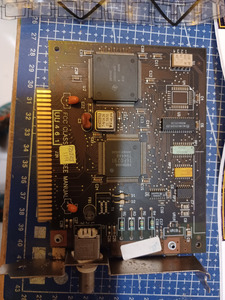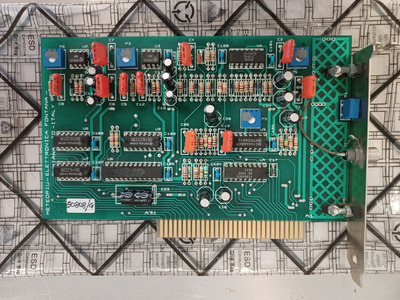mig81 wrote on 2024-01-19, 10:23:
Thanks a lot for repling.....I though it was a LAN card for PC....sorry
It is a LAN card, just not an Ethernet LAN card.
When you go to stuff this old, it's not safe to assume everything conforms to the same standards everything uses today - even if the connector looks familiar. Back in the 1980s, Ethernet was just one of many networking technologies. You had ARCNet, Token Ring, LocalTalk, EcoNET to name but a few as well as a number of these proprietary mainframe connectivity things.
Now, as for Ethernet, there are a lot of cards, and BNC connectors were indeed commonest. To connect two computers with Ethernet via BNC, you need the cards themselves, 50 Ohm coax with BNC connectors, but also two BNC T-connectors and two BNC terminators. The idea is that Ethernet with BNC is a bus that must be terminated at both ends, and unlike other technologies that need termination, like SCSI, the cards don't offer that termination. You use the T-connectors to connect computers to the bus. coax between them and then those terminators on the end.
Note that any break in the chain will bring the whole network down. Also note voltages are quite a bit higher than with UTP - don't put a live BNC connector in your mouth (and don't ask how I found that one out 😜 )
BNC coax networks are quite a pain and it's no coincidence Ethernet only started to become dominant after UTP was introduced. To connect a BNC network to a UTP network, you need either a transceiver or a bridge. A transceiver is a layer 1 device, taking the physical signals of one type and convert it to signals of the other type. By default they are bi-directional. A UTP hub with BNC port is acting as a tranceiver, and is probably the easiest way to do this. Note that you still need the T-connector and terminator for the BNC connector of the transceiver. A bridge is a layer 2 device, that actually takes the frames off the one network and retransmits them on the other. This has the advantage of isolating two separate collision domains, but the disadvantage of adding a bit of latency. A computer with two NICs configured to bridge them is the easiest way to do this.
Now, I actually have a box of cabling, connectors and terminators for this stuff, as well as a dedicated transceiver, so I could run my vintage stuff - or at least the older ones - using BNC. And I've used this stuff back in the day including being sysadmin for a network built on it, so there's a clear nostalgia factor. Still, it's in that box not doing anything. It's just too fiddly and my setup is so network-dependent (all systems are networked and I use FTP to distribute files to the systems) I don't want the hassle.
Instead, I just use UTP NICs. Now, 8b ISA NICs with UTP are pretty rare and if you find them frequently pretty crap (3Com Etherlink I or II...) and they tend to be very expensive too. So what do I use in my XT? An Intel 8/16 LAN adapter. It's 16b ISA, but as the name suggests, operation in 8b ISA buses is explicitly supported. It's a solid card, and is supported by mTCP - and is common and affordable; there's one on a well-known auction site for less than EUR 20 at the moment (and another in US for less than USD 20).
Edit: whoops - see that wierd_w already mentioned almost all the same points on BNC networking while I was slowly (at work...) typing this post.

